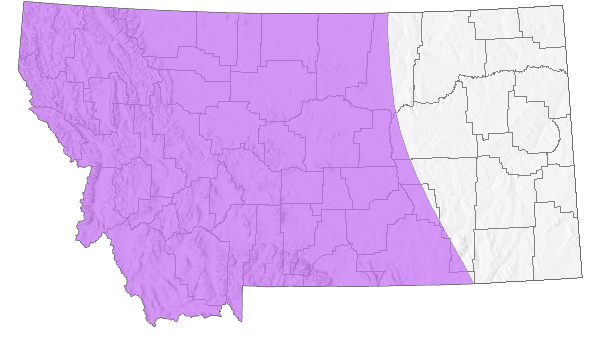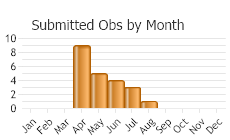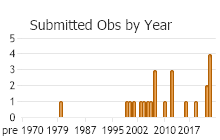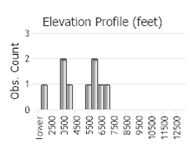View in other NatureServe Network Field Guides
NatureServe
Montana
Utah
Wyoming
Idaho
Wisconsin
British Columbia
South Carolina
Yukon
California
New York
Southern Rocky Mountain Orangetip - Anthocharis julia
Other Names:
Anthocharis sara [misapplied]
Native Species
Global Rank:
G5
State Rank:
S5
Agency Status
USFWS:
USFS:
BLM:
External Links
General Description
Taxonomy of western North American Anthocharis sara complex is in flux, with some authorities elevating the subspecies stella and julia to full species, but using inconsistent ranges among treatments. Other authorities use the species name julia for this taxon in Montana and consider stella a subspecies of julia restricted to the California Sierra Nevada (the subspecies in Montana being A. j. julia). Yet other authorities retain sara as the full species name for these subspecies for now, with julia the Montana subspecies (Kohler 1980; Geiger and Shapiro 1986; Scott 1986; Opler and Wright 1999; Glassberg 2001; Guppy and Shepard 2001; Pyle 2002; Warren 2005; Scott et al. 2008). Most recently (February 2017), the species present in Montana is considered to be A. sara, with the subspecies in western Montana designated as A. s. sulphuris (S. Kohler pers. comm.), possibly with julia as the subspecies in central Montana; the name stella should not be applied to any populations in the state. Sections of this account probably include information for more than one taxon now considered by some as a full species. [See also the account for Pacific Orangetip (Anthocharis sara)]
[From Ferris and Brown 1981; Scott 1986; Opler and Wright 1999; Glassberg 2001; Pyle 2002] Forewing 1.6-2.3 cm. Uppersurface of both sexes with orange forewing tip (bright orange in Pacific male, paler in "Stella" male), male base color white to cream-white, female pale yellow, both sexes with variable black barring on forewing framing orange patch, females with pale yellow capping the orange patch outwardly. Undersurface marbling on forewing and hindwing granular and yellow-green, with yellow along veins.
Phenology
One flight, March to June (Scott 1986). February to early April in south, March to mid-July in Pacific Norhtwest, mid-July to mid-August in mountains, May to July in Colorado (Glassberg 2001). March to early August in the Rocky Mountain region (Ferris and Brown 1981), late May to late June in southcentral Colorado (Scott and Scott 1978), mid-March to mid-August in Oregon and Washington (Pyle 2002), late February to mid-August (Warren 2005), late April to August in British Columbia (Threatful 1988; Guppy and Shepard 2001).
Diagnostic Characteristics
Unmistakable. Best determined by combination of orange patch on forewing tips, white to pale-yellow base color, yellow-green marbling with yellow veins on hindwing undersurface.
Species Range
Montana Range
Range Descriptions

 Native
Native
Range Comments
Under some treatments, Anthocharis sara now restricted to Pacific Coastal region from southeastern Alaska to northern Baja California and east to the east slope of the Cascade and Sierra Nevada mountains, with A. stella extending east from the east slope of the Cascade and Sierra Nevada mountains to the eastern foothills of the Rocky Mountains from Alberta to southern Wyoming (Opler and Wright 1999; Guppy and Shepard 2001). Other treatments include Pacific Orangetip with the former Sara Orangetip as A. sara including Stella Orangetip, ranging throughout western North America from southeastern Alaska and southern Yukon to northern Mexico, east to the eastern foothills of the Rocky Mountains from Alberta to New Mexico and Texas (Scott 1986; Glassberg 2001). Still other treatments split the former A. sara into two species, with Pacific Orangetip (A. sara) in the Pacific Coastal region as noted above but also ranging inland throughout the southwestern US east to New Mexico and southwestern Colorado. The only orangetip species in Montana under this treatment is A. julia , which incorporates the Stella Orangetip (A. stella) as a subspecies of julia but restricted to California (Scott et al. 2008); former A. sara present from 1707 m to 3505 m elevation in Colorado (Brown 1957; Scott and Scott 1978; Scott et al. 2008), 1707 m to 2774 m elevation in Colorado (Scott et al. 2008), near sea level to at least 2377 m elevation in Oregon (Warren 2005), 456 m to 640 m elevation in southeastern British Columbia (Threatful 1988). In Montana, reported from at least 35 counties across the western 1/2 of the state (Kohler 1980; Stanford and Opler 1993), to at least 1981 m elevation (Scott et al. 2008). Common (Glassberg 2001).
Observations in Montana Natural Heritage Program Database
Number of Observations: 40
(Click on the following maps and charts to see full sized version)
Map Help and Descriptions
Relative Density

Recency



 (Observations spanning multiple months or years are excluded from time charts)
(Observations spanning multiple months or years are excluded from time charts)
Migration
Non-migratory.
Habitat
Open habitats, ponderosa/lodgepole pine forest, montane meadows, foothill canyons, sagebrush steppe, roadsides, old fields, grasslands, above treeline in alpine tundra (Shapiro 1977; Scott 1986; Opler and Wright 1999; Glassberg 2001; Pyle 2002; Warren 2005; Scott et al. 2008). In Glacier National Park, Montana reported (as A. sara) from transition areas between open and forested habitat (Debinski 1993); in the Greater Yellowstone Ecosystem, reported (as A. sara stella) from aspen woodlands and meadows (Debinski and Pritchard 2002).
Food Habits
Larval food plants are various native and exotic mustards, including Arabis (multiple species), Athysanus, Barbarea (several species), Brassica (multiple species), Cardamine, Caulanthus, Erysimum, Capsella, Dentaria, Descurainia, Hirschfeldia, Raphanus, Sinapis, Sisymbrium, Streptanthus (several species), Thysanocarpus, and Tropaeolum (Ferris and Brown 1981; Scott 1986, 1992; Guppy and Shepard 2001; Graves and Shapiro 2003; Warren 2005; James and Nunnallee 2011). Adults feed on flower nectar (including Amsinckia, Collinsia, Erigeron, Frageria, Mimulus, Phlox, Taraxacum) and mud (Pyle 2002; James and Nunnallee 2011; Scott 2014).
Reproductive Characteristics
Females lay eggs singly on underside of host plant leaves and inflorescences, larval found on all parts of host plant, including stems and fruits; female may lay about 100 eggs over two days (Scott 1986, 1992; James and Nunnallee 2011). Eggs hatch in about 3-4 days (depending on temperature), develop to L5 instar in about 16-20 days, larvae wander before pupation on vertical stick away from host plant. Larvae solitary, build no nest, overwinter as pupae, some pupae may take 2-3 years before producing adults (Scott 1979, 1986; James and Nunnallee 2011). Males patrol throughout the day in valley bottoms and hillside draws in search of females (Scott 1975b, 1986).
Stewardship Responsibility
References
- Literature Cited AboveLegend:
 View Online Publication
View Online Publication Brown, F.M. 1957. Colorado Butterflies. Proceedings; Numbers Three through Seven. Denver Museum of Natural History, Denver, Co.
Brown, F.M. 1957. Colorado Butterflies. Proceedings; Numbers Three through Seven. Denver Museum of Natural History, Denver, Co. Debinski, D. 1993. Butterflies of Glacier National Park, Montana. Occasional Papers of the Museum of Natural History, the University of Kansas, Lawrence, Kansas. No. 159: 1-13.
Debinski, D. 1993. Butterflies of Glacier National Park, Montana. Occasional Papers of the Museum of Natural History, the University of Kansas, Lawrence, Kansas. No. 159: 1-13. Debinski, D.M. and J.A. Pritchard. 2002. A field guide to the butterflies of the Greater Yellowstone Ecosystem. Lanham, MD: Roberts Rinehart Publishers. 107 p.
Debinski, D.M. and J.A. Pritchard. 2002. A field guide to the butterflies of the Greater Yellowstone Ecosystem. Lanham, MD: Roberts Rinehart Publishers. 107 p. Ferris, C.D. and F.M. Brown (eds). 1981. Butterflies of the Rocky Mountains. Univ. of Oklahoma Press. Norman. 442 pp.
Ferris, C.D. and F.M. Brown (eds). 1981. Butterflies of the Rocky Mountains. Univ. of Oklahoma Press. Norman. 442 pp. Geiger, H. and A.M. Shapiro. 1986. Electrophoretic evidence for speciation within the nominal species Anthocaris sara (Pieridae). Journal of Research on the Lepidoptera 25(1): 15-24.
Geiger, H. and A.M. Shapiro. 1986. Electrophoretic evidence for speciation within the nominal species Anthocaris sara (Pieridae). Journal of Research on the Lepidoptera 25(1): 15-24. Glassberg, J. 2001. Butterflies through Binoculars: A Field Guide to the Butterflies of Western North America. Oxford University Press.
Glassberg, J. 2001. Butterflies through Binoculars: A Field Guide to the Butterflies of Western North America. Oxford University Press. Graves, S.D. and A.M. Shapiro. 2003.Exotics as host plants of the California butterfly fauna. Biological Conservation 110: 413-433.
Graves, S.D. and A.M. Shapiro. 2003.Exotics as host plants of the California butterfly fauna. Biological Conservation 110: 413-433. Guppy, C.S. and J.H. Shepard. 2001. Butterflies of British Columbia: including western Alberta, southern Yukon, the Alaska Panhandle, Washington, northern Oregon, northern Idaho, northwestern Montana. UBC Press (Vancouver, BC) and Royal British Columbia Museum (Victoria, BC). 414 pp.
Guppy, C.S. and J.H. Shepard. 2001. Butterflies of British Columbia: including western Alberta, southern Yukon, the Alaska Panhandle, Washington, northern Oregon, northern Idaho, northwestern Montana. UBC Press (Vancouver, BC) and Royal British Columbia Museum (Victoria, BC). 414 pp. James, D.G. and D. Nunnallee. 2011. Life histories of Cascadia butterflies. Corvallis, OR: Oregon State University Press. 447 p.
James, D.G. and D. Nunnallee. 2011. Life histories of Cascadia butterflies. Corvallis, OR: Oregon State University Press. 447 p. Kohler, S. 1980. Checklist of Montana Butterflies (Rhopalocera). Journal of the Lepidopterists' Society 34(1): 1-19.
Kohler, S. 1980. Checklist of Montana Butterflies (Rhopalocera). Journal of the Lepidopterists' Society 34(1): 1-19. Kohler, S. 2017. Personal communication regarding records, status, and range of former Sara Orangetip (Anthocharis sara) in Montana. 6 February 2017.
Kohler, S. 2017. Personal communication regarding records, status, and range of former Sara Orangetip (Anthocharis sara) in Montana. 6 February 2017. Opler, P.A. and A.B. Wright. 1999. A field guide to western butterflies. Second edition. Peterson Field Guides. Houghton Mifflin Company, Boston, Massachusetts. 540 pp.
Opler, P.A. and A.B. Wright. 1999. A field guide to western butterflies. Second edition. Peterson Field Guides. Houghton Mifflin Company, Boston, Massachusetts. 540 pp. Pyle, R.M. 2002. The butterflies of Cascadia: a field guide to all the species of Washington, Oregon, and surrounding territories. Seattle Audubon Society, Seattle, Washington. 420 pp.
Pyle, R.M. 2002. The butterflies of Cascadia: a field guide to all the species of Washington, Oregon, and surrounding territories. Seattle Audubon Society, Seattle, Washington. 420 pp. Scott, J.A. 1975b. Mate-locating behavior of western North American butterflies. Journal of Research on the Lepidoptera 14:1-40.
Scott, J.A. 1975b. Mate-locating behavior of western North American butterflies. Journal of Research on the Lepidoptera 14:1-40. Scott, J.A. 1979. Hibernal diapause of North American Papilionoidea and Hesperioidea. Journal of Research on the Lepidoptera 18(3): 171-200.
Scott, J.A. 1979. Hibernal diapause of North American Papilionoidea and Hesperioidea. Journal of Research on the Lepidoptera 18(3): 171-200. Scott, J.A. 1986. The butterflies of North America: a natural history and field guide. Stanford University Press, Stanford, California.
Scott, J.A. 1986. The butterflies of North America: a natural history and field guide. Stanford University Press, Stanford, California. Scott, J.A. 1992. Hostplant records for butterflies and skippers (mostly from Colorado) 1959-1992, with new life histories and notes on oviposition, immatures, and ecology. Papilio new series #6. 185 p.
Scott, J.A. 1992. Hostplant records for butterflies and skippers (mostly from Colorado) 1959-1992, with new life histories and notes on oviposition, immatures, and ecology. Papilio new series #6. 185 p. Scott, J.A. 2014. Lepidoptera of North America 13. Flower visitation by Colorado butterflies (40,615 records) with a review of the literature on pollination of Colorado plants and butterfly attraction (Lepidoptera: Hersperioidea and Papilionoidea). Contributions of the C.P. Gillette Museum of Arthopod Diversity. Fort Collins, CO: Colorado State University. 190 p.
Scott, J.A. 2014. Lepidoptera of North America 13. Flower visitation by Colorado butterflies (40,615 records) with a review of the literature on pollination of Colorado plants and butterfly attraction (Lepidoptera: Hersperioidea and Papilionoidea). Contributions of the C.P. Gillette Museum of Arthopod Diversity. Fort Collins, CO: Colorado State University. 190 p. Scott, J.A. and G.R. Scott. 1978. Ecology and distribution of the butterflies of southern central Colorado. Journal of Research on the Lepidoptera 17(2): 73-128.
Scott, J.A. and G.R. Scott. 1978. Ecology and distribution of the butterflies of southern central Colorado. Journal of Research on the Lepidoptera 17(2): 73-128. Scott, J.A., M.S. Fisher, D.M. Wright, S.M. Spomer, N.G. Kondla, T. Stout, M.C. Garhart, and G.M. Marrone. 2008. Geographic variation and new taxa of western North American butterflies, especially from Colorado. Papilio new series # 19. 79 p.
Scott, J.A., M.S. Fisher, D.M. Wright, S.M. Spomer, N.G. Kondla, T. Stout, M.C. Garhart, and G.M. Marrone. 2008. Geographic variation and new taxa of western North American butterflies, especially from Colorado. Papilio new series # 19. 79 p. Shapiro, A.M. 1977. The alpine butterflies of Castle Peak, Nevada County, California. Great Basin Naturalist 37(4): 443-452.
Shapiro, A.M. 1977. The alpine butterflies of Castle Peak, Nevada County, California. Great Basin Naturalist 37(4): 443-452. Stanford, R.E. and P.A. Opler. 1993. Atlas of western USA butterflies: including adjacent parts of Canada and Mexico. Unpubl. Report. Denver and Fort Collins, Colorado 275 pp.
Stanford, R.E. and P.A. Opler. 1993. Atlas of western USA butterflies: including adjacent parts of Canada and Mexico. Unpubl. Report. Denver and Fort Collins, Colorado 275 pp. Stout, Todd L. 2018. A review of three species-level taxa of the Anthocharis sara complex (Lepidoptera: Pieridae: Pierinae: Anthocharidini). Insecta Mundi. 0615:1-38.
Stout, Todd L. 2018. A review of three species-level taxa of the Anthocharis sara complex (Lepidoptera: Pieridae: Pierinae: Anthocharidini). Insecta Mundi. 0615:1-38. Threatful, D.L. 1988. A list of the butterflies and skippers of Mount Revelstoke and Glacier National Parks, British Columbia, Canada (Lepidoptera). Journal of Research on the Lepidoptera 27(3-4): 213-221.
Threatful, D.L. 1988. A list of the butterflies and skippers of Mount Revelstoke and Glacier National Parks, British Columbia, Canada (Lepidoptera). Journal of Research on the Lepidoptera 27(3-4): 213-221. Warren, A.D. 2005. Lepidoptera of North America 6: Butterflies of Oregon, their taxonomy, distribution, and biology. Contributions of the C. P. Gillette Museum of Arthropod Diversity, Colorado State University. Fort Collins, Colorado. 406 pp.
Warren, A.D. 2005. Lepidoptera of North America 6: Butterflies of Oregon, their taxonomy, distribution, and biology. Contributions of the C. P. Gillette Museum of Arthropod Diversity, Colorado State University. Fort Collins, Colorado. 406 pp.
- Additional ReferencesLegend:
 View Online Publication
View Online Publication
Do you know of a citation we're missing? Allen, T.J., J.P. Brock, and J. Glassberg. 2005. Caterpillars in the field and garden: a field guide to the butterfly caterpillars of North America. Oxford University Press.
Allen, T.J., J.P. Brock, and J. Glassberg. 2005. Caterpillars in the field and garden: a field guide to the butterfly caterpillars of North America. Oxford University Press. Brock, J.P. and K. Kaufman. 2003. Kaufman Field Guide to Butterflies of North America. Houghton Mifflin Company, New York, NY 284 pp.
Brock, J.P. and K. Kaufman. 2003. Kaufman Field Guide to Butterflies of North America. Houghton Mifflin Company, New York, NY 284 pp.
- Web Search Engines for Articles on "Southern Rocky Mountain Orangetip"
- Additional Sources of Information Related to "Insects"





